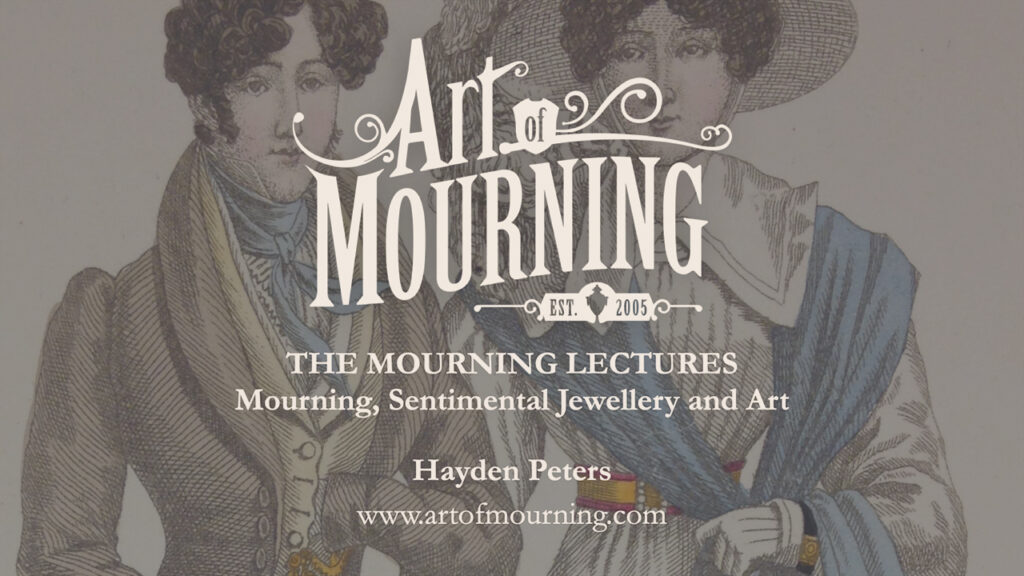Overview of Mourning Miniture Portraits
Personal identity and representing the family in jewellery and objects is as much a nationalistic symbol, as it is one of self pride. The rise in popularity of the miniature portrait has a direct line to royal patronage and suits the changing value of the upper class. With the Renaissance offering a new way of influencing life with humanism and philosophy, the miniature portrait’s focus of being dedicated solely as the focus of the art leaves room for their personal values and wealth to be seen.
Originally known as limnings, the process was separate from what were other forms of art. The title ‘miniature’ is derived from the Latin miniare, which means to colour with red lead. Illuminated books that were painted on vellum with watercolour were known as limnings, which derives from the Latin luminare (to give light).
The earliest miniatures known during this period were by Jean Clouet at the court of Francis I. Flemish illuminators became well known for this style and its notoriety grew. Lucas Horenbout led the English fascination with portrait miniatures, as his work was commissioned under Henry VIII. Horenbout taught this technique to Hans Holbein the Younger (1497/8-1543). Holbein’s success at the court of Henry VIII led to his status of King’s Painter to Henry VIII of England by 1535. This is an integral role for Henry, as the products being designed by Holbein would be the ones to establish a new English identity, with the depiction of royalty setting the standard for what the public would emulate.
The popularity that stemmed from this work elevated the miniaturist’s position in society. Nicholas Hilliard (1547-1619) had his first sitting with Queen Elizabeth in 1572 and this led to a fruitful career as ‘our goldsmith’ and limner to the Queen. This patronage would earn him an annual allowance of £40 per year. Trained as a jeweller under Robert Brandon, his progression into miniature portraits was an organic one and also one he could infuse with other jewellery techniques. He wrote The Art of Limning in c.1598, where he credits Hans Holbein the Younger and Albrecht Dürer as influences in his art. From his writing, his philosophy and approach to his style shows the high level of respect and detail he was viewing within his sitters, in order to bring out their inner nature. There is also a respect for the craft, as he writes “Limning, a thing apart… which excelleth all other painting whatsoever.”
Miniature portraits eventually were replaced by photography in the 19th century, but their development from the 15th century came from royalty and led to their availability amongst mass society. The development of schools and competing miniaturists drove cost in both directions, with some being of exceptional quality, and others being pre-designed to a classical ideal, then tailored to the features of the person who was being represented.
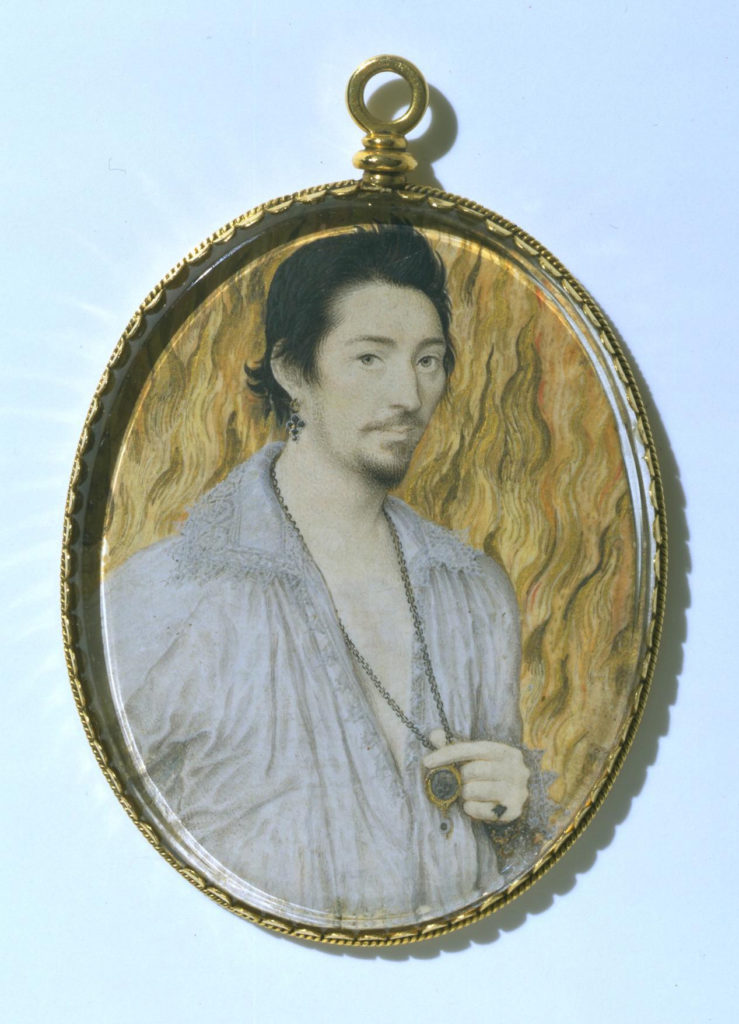
The word miniature stems from the Latin word ‘miniare’, or ‘to colour with red lead’. This was due to first painted and decorated hand written books utilised illustration and ‘to colour with red lead’ was a practice used for the capital letters in the fonts. By the 1460s, hand written books had major competition with printed books, yet the wealthy patrons drove demand for luxury goods. The Merchant Class and the rise of new wealth through trade began to elevate by creating luxuries in society, from patronage to artists and dressmakers. Books continued to be hand illustrated because of this, but a new focus on illustrators offering patrons miniatures as items of class and desire became a new discipline.
By the 1520s, the French and English courts introduced portrait miniatures as fashionable items. Jean Clouet in France and Lucas Horenbout in England were two of the earliest miniaturists, displaying their work in jewels that could be worn around the neck, or in setting that were held. These tokens could be given unframed and the subject was the one who chose the locket for it to be placed in, combining the sentimentality of just be given a jewel. Miniatures became fashionable gifts to the monarchy, as a personal gift or one of public ceremony during the time between 1580-1625.
Loyalists to the Crown during the time of Elizabeth I was a way for society to show solidarity at a time when Catholic Spain was a threat. Miniaturists such as Nicholas Hiliard and Issac Oliver became famous through their miniature portraits, leading to an incredibly high demand through the upper classes. This is the inception of many of the mourning and sentimental jewels that drove a bottom-up groundswell of jewellery production through the 17th century. Miniatures are representations of piety and propaganda. When a fashion it used by a monarch, then it is copied by the populace. Here, Elizabeth’s power of image was copied readily by succeeding monarchs.
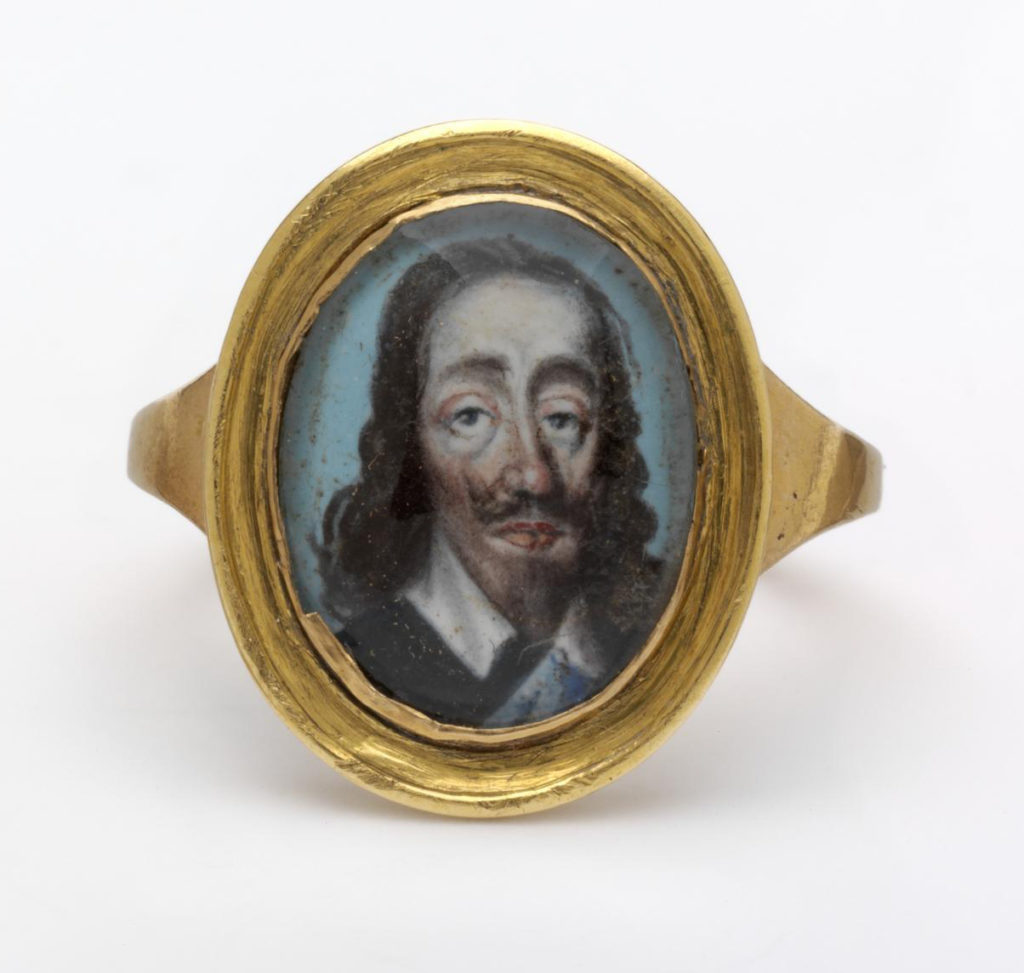
Mourning portraits of Charles I were worn by loyalists to show their solidarity with the Crown and the hope that it would some day be restored. Hidden inside lockets and rings, these often captured the image of Charles looking up. During the successive Cromwell period, miniaturists, such as Samuel Cooper, still continued past the 1649 period, capturing even the image of Oliver Cromwell himself. He became the leading miniaturist after the Restoration of Charles II, becoming the king’s limner in 1663.
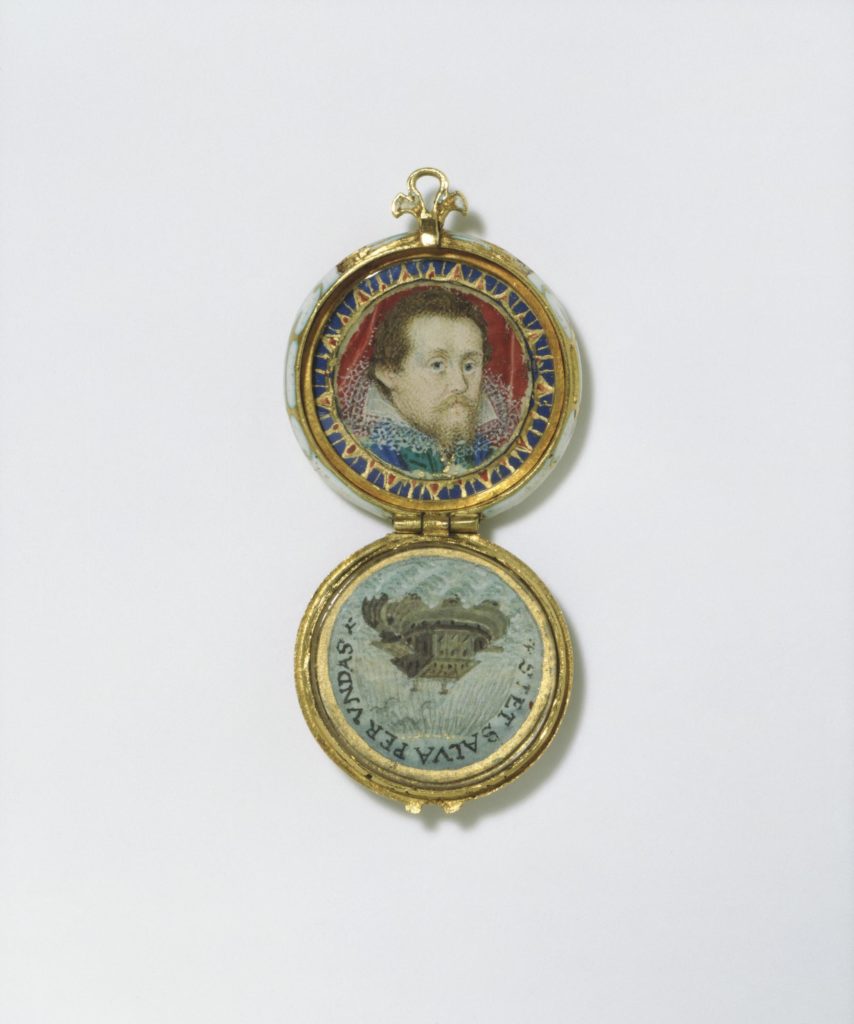
Mourning jewellery that features the miniature portrait style as its most predominant had its origins in the post c.1760 period. Archaeological excavation was an important element to the growth of classical culture in the 18th century. Digs in Pompeii and Herculaneum had discoveries in 1711, but resumed with major excavations in 1738, igniting the passion and interest in artists, thinkers and antiquarians. What stemmed from this was a change in how life and death were represented in jewellery. A major humanist movement in the Enlightenment followed the Neoclassical era, which allowed for questioning of traditional concepts of life and social structure.
Since the Reformation and its impact upon religious thought, society was changing to look at itself in an individual way. Guilds, education and disseminated thought allowed for people to learn new concepts that were prohibited from earlier generations. New skills and crafts meant that an individual could break away from the family unit and learn something that was outside of the family craft. By the Neoclassical period of the late 18th century, industrialisation allowed for middle classes to grow new wealth, something the merchant classes had previously began to appreciate through importing and exporting goods globally.
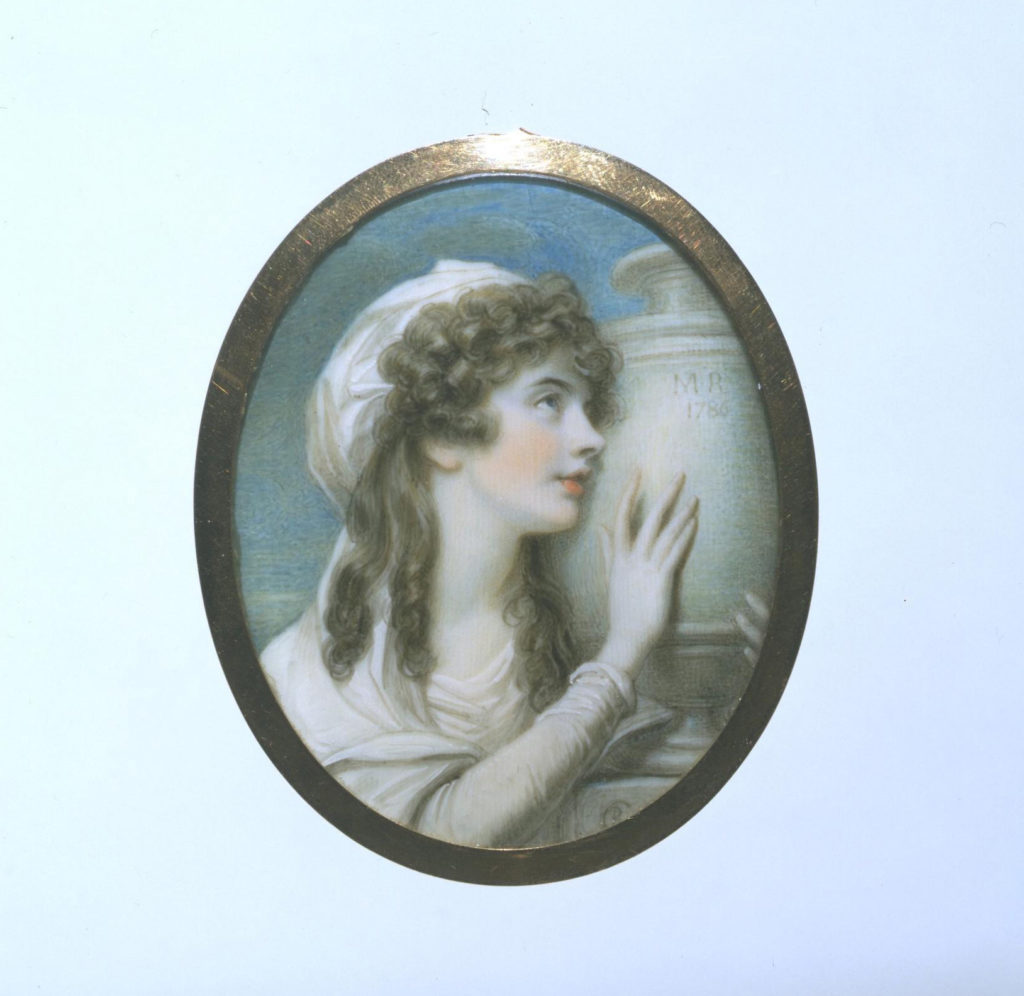
To achieve the quality of miniature portraits in the 18th century, miniaturists focused on their own methodologies for improvement. The above example of by Cosway shows the pinnacle of the Neoclassical period, with the subject beautifully rendered in soft tones. This could not have been possible without innovation. Bernard Lens, c.1707, was the first British artist to paint on ivory, as the previous popular material for painting was vellum. This allowed for the canvas to become smaller and jewels could adapt to these smaller sizes. Enamel portraits were small and popular, while the watercolour on ivory allowed for more detail on a smaller space, while on vellum, capturing detail was harder. Miniature painting became a pastime, rather than a learned skill until the 1760s. Changes in the development of the paintings included roughing and degreasing the ivory, as well as stickier paints. William Shipley(1715 – 1803) founded an arts society in London, which developed into The Royal Society of Arts in 1754, the first school of its kind in London. Young students enlisted, such John Smart and Richard Conway, who would influence the art that was to come.

In 1768, the Royal Academy of Arts was founded through a personal act of King George III, to promote the arts and design in Britain through exhibition and education. At this time, the competition between miniaturists for business and rapid improvements in painting technologies fed a hungry audience who drove miniatures into high demand.

Between the 1800-1840 period, miniatures had become part of the popular sentimental token lexicon. Having a miniaturist paint the portrait of a loved one was not just relegated to the aristocracy, but a middle class as well. For a period where there was high mobility globally, through war, trade, travel or colonisation, the giving of a gift of remembrance was never in such high demand. This led to many variations of the style of miniature that was requested for painting, or where the miniature was placed, such in the above ring. Later in the article, this can be seen in silhouettes and eye portraits.
As a token of remembrance, this miniature reflects the subject in washed out colours and dark background, with short, sharp strokes refining the higher colours and detail. Seen in the red and brown highlights of the hair as well as the colour around the ears, these remain the highlights of the colour. The face is pallid and there is a dark shade around the eyes. All are captured in exceptionally fine detail and do not conform with a simple idyllic depiction of a child from the time.
Upon the reverse, there is the most pristine mourning sepia depiction that a jewel could ever accommodate. Its design is crisp, sharp and confident in its message. Note the willow design and how its crisp leaves and bend to the trunk match the following example:
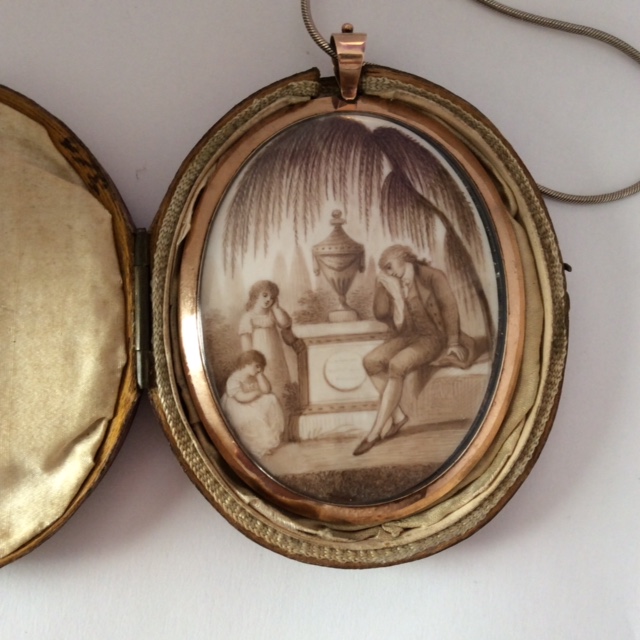
The willow was one of the earliest Neoclassical mourning symbols to be perfected, as its use as a framing device for the ivory of a jewel was ubiquitous and one of the most common of all designs. The urn, perfectly shaded, is large enough to show the complex detail within. From its design, the vessel is drawing the perspective of the willow, making it the dominant focus of the miniature, an allusion to the love that is reflected in the scale. This is the love for the deceased, being larger than anything else in its scope. Even the the drapery to the plinth is deeply rendered, showing the three-dimensional aspect to the design. This is a painting that is confident and direct in its focus. There’s no experimentation in its style, as it is clearly telling a message through its symbolism. The sharp brushstrokes and thick lines all correlate with a standard of design that could be worn and reflected in daily life and society.
It is affecting to think that a jewel without a locket that shows the face of the deceased would have been worn at the neck or bodice, on display for those who know that the lady in question was in mourning. Lockets would become the typical standard of wearing a portrait or a photograph, something which had its precedent based in the 16th century. It is a private ceremony of wearing the jewel under anonymity, yet this jewel wears it as its most prominent feature.

Photography was the eventual downfall of the miniature portrait era. Miniature portrait painters eventually moved into photography post c.1839 and the styles which were popular moved into high detail paintings, reflecting those of a full canvas painting. This became too expensive for regular tokens of affection and improvements and in photographic technologies made them smaller and cheaper to afford. Of note, Sir William Charles Ross (1794 – 1860) painted Queen Victoria in 1837 and gained notoriety, enough so that he painted Queen Adelaide, the Prince Consort and children, as well as other monarchs throughout Europe. His style was highly detailed and matching this by other miniaturists was too costly for even the higher classes.
After a short revival in the late 19th century, the Royal Society of Miniature Painters was founded in 1898 and granted a Royal Charter by King Edward VII in 1904. A Romantic revival at the turn on the 20th century led to miniatures being found in the same styles as those of the early 19th century. Eye miniatures, romantic miniature portraits of families and children were popular, as were the settings they were in. Much the same as this jewel depicts the contemporary fashion of the child and the typical symbols of Neoclassical mourning, jewels of the early 1900s have subjects in 19th century dress.
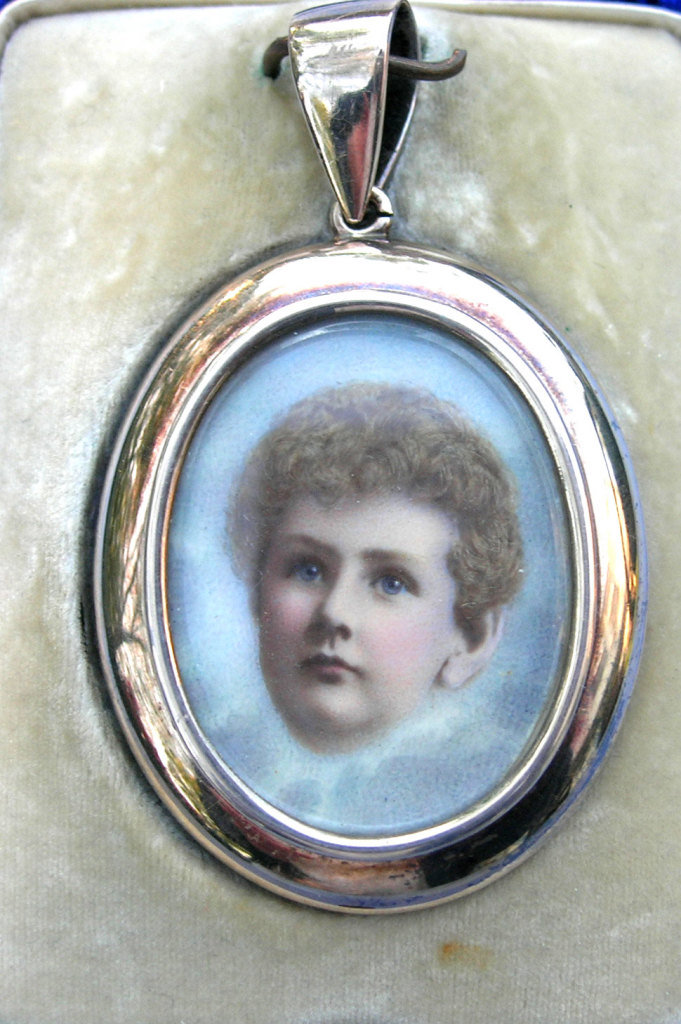
The trajectory of the miniature portrait mirrors that of modern society. As new education and sharing of ideas became something that was not an absolute privilege, but something that could be attained by a growing middle class and the new wealth that could finance it.
This is why the early 19th century is an important once. The tokens of love and affection that became so popular in daily life were now accessible in higher volumes with greater variation to the style. In the miniature for the boy, there is a great deal of detail and the obvious wealth is also shown in the setting of the pendant. The acanthus and floral border is thickly designed and quite fashionable. It’s an affectation that could have been bland and simple, but the wearer has put a great deal of care into this element of the design.

The above piece for Louisa Bohun is dated for 1816, the year she died at age 18. Her younger sister Frances has has her hair in the reverse of the locket and she died at age 15 the same year. What is important in this interesting miniature is that she is dressed in Elizabethan period costume. To be able to have a miniature, which may have been preexisting, shows that there is enough social mobility for the wealthy family (their father was a solicitor), to have created family tokens of love. The locket is possibly a collection of different elements, such as the hair of the sister in the reverse and the miniature itself, but it could be compiled from available elements at the time. As a subject in period costume, it is a charming fancy to have a keepsake of the loved one.

Due to the proliferation of miniatures and artists in the first quarter of the 19th century, other offshoots in painting tokens of sentimentality appeared. Shades, or silhouettes, were popular and fast ways of capturing a moment and keeping that within the family. Eye miniatures and various other contemporary sentimental fads retained their popularity until the advent of affordable photography.
What this shows is that the art of the miniature portrait is a combination of different factors. Technologies and improvements in the method led to faster and more precise work within the art. The sharing of knowledge through schools and academies influenced young artists who could not have had the chance to make a trade out of a cultural phenomenon and the market expanded as people had access to wealth. The product of this is the miniature above. It has captured a child in excellent detail and persevered this image for generations.
Through the proliferation of the physical image, culture and society could share fashion throughout the world. More importantly, individuals could share their own image and sentimental keepsakes became more than just the values of a system, government, class or religion, but about the self. As these could carry through the world, their values did as well, making the individual the most important keepsake of all.




